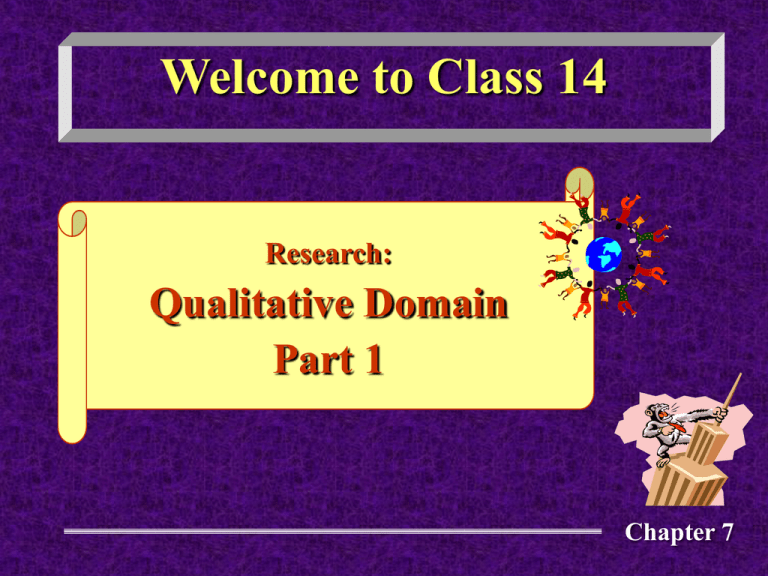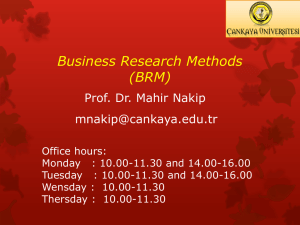Class14
advertisement

Welcome to Class 14 Research: Qualitative Domain Part 1 Chapter 7 Qualitative Performance Qualitative performance data is information associated with an organization's: 1. Tactical and Strategic planning processes 2. Decision-making 3. Behaviors 4. Interaction with each of its stakeholders Qualitative performance data is a window into a firm's personality and character. Generally, it is NOT POSSIBLE to measure the impact of qualitative performance in quantifiable terms – BUT … – this should not be mistaken as a zero-influence factor. The consequences of qualitative performance are at least as significant in determining a firm's long-term viability as its financial performance. Resources Quantitative & Qualitative Resources Corporations have two major classes of crucial valuables: (1) Quantitative resources (2) Qualitative resources The techniques and competence with which TMTs corral, coalesce, and utilize these can determine whether a corporation achieves its goals and objectives. The focus of this lecture is on qualitative resources however quantitative resources are highlighted for comparison purposes. 1. Quantitative Resources $$$ Also known as Financial Resources Quantitative resources = tangible and intangible assets These resources can be measured and managed in numerical terms. Tangible assets = facilities, equipment, inventories, receivables, investments, financial resources, etc. Intangible assets = patents, copyrights, goodwill, etc. (Intangibles lack physical substance and are classified as – noncurrent – items on the firm's balance sheet) 2. Qualitative Resources Qualitative resources are sometimes referred to as intangible resources. These resources offer great value to an organization but their precise worth cannot be measured or managed in the same way as quantitative resources. Although it is impossible to establish a precise value for qualitative resources, they contribute significantly to a firm’s long-term viability. Qualitative resources coalesce to form a company’s core capabilities Qualitative resources include such things as: The Knowledge, Skills, and Abilities of all of its employees The Reputation of the firm The Positive Relationships the firm has established Its record of positive and productive – Decision-making, Actions, and Behaviors Its Infrastructure – Communication Networks, Operational systems and procedures, etc. Scenario and strategic planning expertise Action = what you do Behavior = how you do it Performance Qualitative Performance Sustainable success by any corporation is correlated to its qualitative performance There are two primary areas of qualitative performance: (1) Organizational Citizenship (OC) (2) Strategic Positioning (SP) Both OC and SP are propelled by unique performance drivers and among these drivers none is more significant than "culture." Organizational Citizenship Organizational Citizenship (OC) = a category of specific corporate behaviors and relationships. OC reveals the firms PERSONALITY and CHARACTER. A significant influence on OC is the firm’s corporate culture. Assessing Organizational Citizenship = investigating a series of behaviors, actions, and decisions that reflect a firm’s: 1. Core personality – (how key personnel act and react to situations, conditions, and people) 2. Core character – (how they are likely to act and react to changing situations and conditions) Create a database for Organizational Citizenship by: 1. Identifying strategic and tactical decisions by TMTs 2. Examining the associated actions and behaviors Investigating Corporate Relationships Requires patience and perseverance. Do not expect to discover clear, unbiased, definitive information. Information related to relationships is, by its very nature, subjective (It is dependent upon perspective). It is important to filter data collected. Search for collaborating information to validate the initial finding. Strengthening the "Researcher-created" Database Two-pronged approach – for Reliability and Comparability 1) Collect qualitative information on the target company from a variety of sources – Filter the information – compare the opinions of different sources and look for irrational biases within sources. Eliminate the conclusions of sites that reflect these biases. 2) Collect similar data on other organizations – Cross-company comparisons help determine whether the target company is behaving within industry norms Create a list of questions to guide the investigation Does the company seem to be sensitive to local communities? Is it responsive to local concerns? Does it have publicized or well-known difficulties with governmental agencies, customers, competitors, or its own board of directors? Does the firm encourage its employees to be culturally sensitive? Does the firm appear to appreciate and respect its employees? What type of relationship does the firm maintain with its competitors? (Competitors do not have to be enemies.) See your textbook for an extensive list of questions Organizational Citizenship Employees Environment Customers Community/ Culture Competitors Stockholders Directors Communication Government Public Persona Vendors (Suppliers) Strategic Positioning Strategic Positioning (SP) = a category of a firm’s creative and planning processes. This area of examination sheds light on the firm's commitment to: (1) Being innovative, creative, and visionary (2) Predicting and adapting to environmental changes (3) Recruiting, developing, and retaining talented employees (4) Executing strategic and tactical plans effectively Competitive viability is dependent upon TMTs who can craft strategically sound plans. There are two types of TMTs: (1) strategically incompetent (2) strategically competent It is important to identify which type is leading your target company (1) Strategic Incompetence = Those who simply point out strategic alternatives but fail to pursue these or do so erratically and inconsistently (talkers and pointers) (2) Strategic Competence = Those who actually take the appropriate actions to strategically position the firm as it moves continuously closer to its primary goals and objectives (the doers) Strategic Incompetence Incompetent TMTs can easily be identified. They will: Continuously find excuses for their failures Continuously pursue the same strategy and expect different results Attempt to justify the validity of their failed strategies by blaming the business environment (recession, inflation, hyper-competition, etc.) for unfulfilled goals and objectives Strategic Competence Competent TMTs can be easily identified. They are willing to acknowledge their strategic and tactical errors and use these as a spring board for future improvements. They do not repeat their mistakes. They think out of the box. They think big, they think on a global scale. They think – INTERNATIONAL TRADE What is international trade? Why is it important to strategic positioning? International trade = The exchange of products and services between countries. International trade = The potential for unimaginable opportunities that can ensure corporate growth and prosperity. Create a list of questions to guide data collection related to a firm’s Strategic Positioning Does the company's TMT think GLOBALLY? Has it taken any actions toward participating in the global market? If so, have these been effective? What plans have been announced for diversification or divestitures? Do these seem realistic? Do Strategies appear to suggest growth in revenue and profits? Is there a clear plan for growth in appropriate areas? Is the Human Resource Management Department part of upper management or is it simply a service department? Respect for the value of human resources is an important ticket on the train to strategic success. (See your textbook for an extensive list of questions) Performance Grading Scale 1 to 5 Directions for Grading Follow PLEASE study these carefully End: Research: Qualitative Domain – Part 1 Assignment: 1. Study the following slides 2. Re-Read “Carefully” Chapter 7 Grading Scale 1 to 5 1 = Really Bad 2 = Bad 3 = Do not know 4 = Good 5 = Excellent Organizational Citizenship – Looking for Outliers Grading Extremes – 1 and 5 Employee Relations [1] Strikes, discontent, class action lawsuits, violence [5] Employee satisfaction, widely acknowledged as a good place to work, awards and recognitions for employee sensitivity Customer Relations [1] Product recalls, misleading advertising, class action lawsuits, customer service department is considered more like a customer insult department [5] Customer satisfaction, reputation for quality products and/or services, strong, friendly, and helpful customer service department Competitor Relations [1] Price wars, name calling in advertising, lawsuits [5] Apparent mutual respect, does not sue or attack competitor in advertising campaign, has strategic partnerships Relationship with Directors [1] Publicized discontent, public criticism of management by directors, rated as Board of Shame by Fortune 500 Magazine [5] Large number of external directors, maintain excellent relationship with those directors, rated as the Board of Fame by Fortune 500 Magazine Government Relations [1] Attorney general lawsuits, SEC or IRS investigations, other governmental problems [5] Received awards and highly recognized for good business practices, no record of governmental problems, awarded government contracts Environmental Record [1] Apparent total lack of concern for the aesthetic and general physical environment [5] Received awards for environmental sensitivity, consistently known as an environmentally concerned corporate citizen Community/Cultural Sensitivity [1] Careless decisions that impact a community with no input from citizens, opens facilities in spite of massive public protest, shows defiance and distain for those with differing opinions, closes facilities with no apparent concern for workers [5] Received awards and highly recognized as a good corporate citizen, supports community and social/cultural activities Stockholder Satisfaction [1] Publicized discontent, calls for resignation of officers, class action suits, losses, restatement of earnings [5] Stockholders appear very satisfied (market price of stock rising), corporate earnings are solid, dividends appear appropriate, market position increasing, assets and earned capital increasing Communication with the Public [1] Secretive, closed to public comment, condescending in comments, refuses to acknowledge or accept any responsibility for bad results [5] Openness, honesty, comfortable with probing questions, no attempt to hide information from the public Public Persona [1] Poor public image, profit more important than any other factor, facilities uninviting, company considered to be a bully [5] Solid public image, consider a good guy company, in all respects is viewed highly by customers and non-customers, considered by a wide range of constituents as committed to doing the right things Vendor Relations [1] Notoriously late in paying debts, lawsuits by suppliers, bankers, and/or other creditors [5] Apparent solid respect by suppliers and other creditors, possesses exclusive licensing agreements Grading Scale 1 to 5 1 = Really Bad 2 = Bad 3 = Do not know 4 = Good 5 = Excellent Strategic Positioning – Looking for Outliers Grading Extremes – 1 and 5 Vision and Mission [1] Vision and Mission statements hard to find, unclear and confusing, or not readily available [5] They are prominently displayed on the company website and/or in other obviously visible places and they appear to be focused, clear, and logical Competitive Advantage [1] The market share of the target company appears to be diminishing. The company appears to be behind the eight ball, getting caught off guard by competition. For the corporate-level strategy consideration, the corporation has not yet established synergies between the companies within its portfolio and there is no evidence that this will happen soon. The company is in a weak position to deal with competitive threats. [5] The target company appears to have a solid rapport with its primary customer base. Strong customer loyalty is obvious. Its products and services are widely recognized. Its name is widely recognized. Its market share is expanding. Its line of products and/or services is expanding and they appear innovative. For corporate-level strategies, synergies have been created between companies within the portfolio and the corporation is in a strong position to deal with competitive threats and to capitalize upon new opportunities. General Environment (Competing companies have little or no control over the general environment. It includes such things as demographic, sociocultural, political/legal, economic, and technological changes.) [1] The target company is frequently caught off guard by general environmental changes. The Management Discussion and Analysis section of the target’s annual report indicates that executives blame general environmental changes for all of the company problems. (It was not our fault; we simply could do nothing about the environment. [5] Company anticipates changes and exhibits the ability to adapt so that it can capitalize on new opportunities that may evolve from a changing general environment. Innovation [1] The Company is continually caught off guard by competitive development of new ideas, products, and/or services. The target company does not innovate and does not support KSA development by employees. [5] The Company has a long tradition of promoting new thoughts and ideas. It is innovative and has a reputation for new discoveries and/or acquisition of new technologies, systems, copyrights, patents and/or the development of new types of services. The Company encourages KSA development of employees at all levels of the organization. Plans and Progress [1] The Company’s is significantly less than stellar. The company’s strategy is confused and unsuccessful. The Company’s financial health is not strong and does not show systemic improvement. The Company has formed no strategic partnerships or if it has, they appear lacking in synergy or diversions from the Company’s core competencies. Company shows no significant interest in expansion. Management does not have a global mentality. [5] The Company has a history of successful expansion and acquisitions. Its plans are announced every year, often in the annual report and they seem well conceived and logical. Progress is admirable and progress reports are publicly announced. The Company continues to experience internal growth as well as growth related to acquisitions and/or new acquisitions. End Class 14 Research: Qualitative Domain Part 1 Chapter 7







